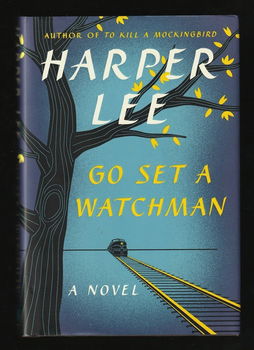Aangeboden door CDJK NIN1
GO SET A WATCHMAN
A novel by HarperLee
Summary
The plot structure of Go Set a Watchman parallels the classic "hero's journey," a common story pattern in which the main character embarks on a difficult quest, the goal of which is to accomplish a noble and challenging task for the good of a group. The plot structure is also similar to English poet Robert Browning's Childe Roland (1855), a poem referenced throughout the story.
Part 1
The story opens with 26-year old on a train headed for Maycomb, Alabama. She has left New York City for her yearly visit to her hometown. Racial tensions are brewing in this 1950s town that has been isolated and slow to accept the social changes occurring in the rest of the country. She is met at the station by , her longtime friend and soon-to-be fiancé, who is now her father's young law partner. The pair arrives at home and conflict begins to emerge between Jean Louise's progressive notions and the old-school Southern ways of her .
Part 2
A visit to Finch's Landing, an estate that has been in the Finch family for many years, unsettles Jean Louise. She is surprised to find it has been sold. She claims this bothers her only because it took place without her knowledge, which shows that she is blind to her own resistance to change.
Part 3
While Hank and , Jean Louise's father, attend a courthouse meeting, Jean Louise discovers a racist pamphlet her father has been reading. Furthermore, she comes to find out her father and Hank are members of the racist Maycomb County Citizens' Council. Jean Louise storms off to the courthouse to listen in on the meeting. She becomes angry and disillusioned. The father she knew as a defender of defenseless blacks, and someone she viewed as morally perfect, is not the man of principles she thought him to be.
Part 4
Atticus is called upon to defend Frank, the grandson of Calpurnia, the Finch's former black cook. Frank accidentally ran over and killed an old white man. Atticus agrees, but not for the reasons Jean Louise would have assumed during her childhood. Meanwhile, Jean Louise is in deep emotional turmoil as she tries to understand what she perceives as puzzling changes occurring within her family and town.
Part 5
Jean Louise visits with her mentor, . He is deemed crazy by many, but Jean Louise has always found him to be straightforward and honest with her. However, now he seems to speak in riddles as she seeks to understand the perceived changes taking place around her.
Part 6
Jean Louise confronts Hank about his views on individual identity within marriage and how he sees his role as a change agent within government. These views differ markedly from her own, and she declares she will not marry him. She then confronts him about the meeting she observed at the courthouse. Atticus overhears the conversation. Jean Louise then confronts Atticus, challenging his views about social justice and societal change, which are different from her own. This difference in Jean Louise's idealized notion of Atticus and the real Atticus fuels her inner turmoil. She angrily compares her father to Hitler and feels he has lied to her all her life.
Part 7
Jean Louise returns to the house to pack her bags and leave. However, Uncle Jack stops her. He helps her see she has to get to know her father for who he is rather than the childish perspective of the person she imagined him to be. Jean Louise's effort to disentangle her conscience from that of her father permits her to strengthen her own moral compass to accomplish a greater good.
Hardcover, 280 pag.
IN NIEUWSTAAT













